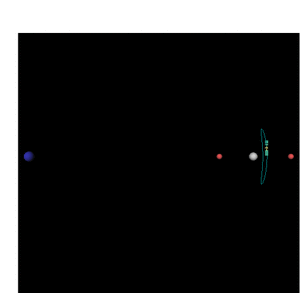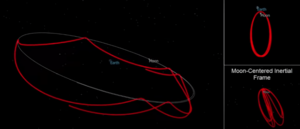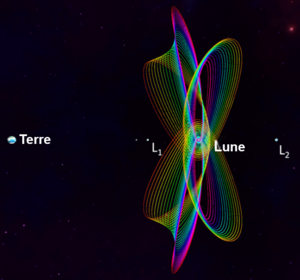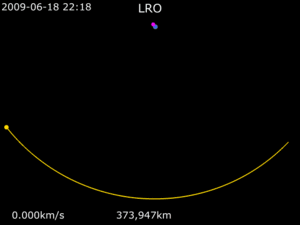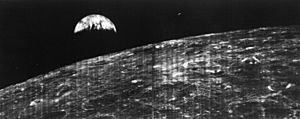Lunar orbit facts for kids
In space, a lunar orbit happens when an object, like a spacecraft, travels around Earth's Moon. You might also hear it called a selenocentric orbit. These orbits are usually not perfect circles.
When a spacecraft is farthest from the Moon in its orbit, it's at a point called apolune. When it's closest to the Moon, it's at perilune. These names come from ancient words for the Moon.
Getting into a lunar orbit is a special move called Lunar Orbit Insertion (LOI). It's like a spacecraft hitting the brakes just right to get caught by the Moon's gravity.
A low lunar orbit (LLO) means a spacecraft is orbiting less than 100 kilometers (about 60 miles) above the Moon's surface. These orbits take about 2 hours to complete. Scientists are very interested in LLOs for exploring the Moon. However, these orbits can be tricky because the Moon's gravity isn't perfectly even. This can make most LLOs unstable, meaning a spacecraft might not stay in orbit for long unless it's in a special "frozen orbit."
Contents
Why are Low Lunar Orbits Tricky?
Most low lunar orbits below 100 km (60 miles) are not stable. This is because of something called mass concentrations or mascons.
Imagine the Moon's gravity pulling on a spacecraft. It's not always a smooth pull. Scientists discovered that some parts of the Moon have more mass, or "stuff," packed into them. These areas are called mascons. They are usually found under large impact craters from long ago.
These mascons create stronger gravity spots that can pull on a spacecraft. This pull can change a spacecraft's orbit quite a bit over just a few days. It's like tiny bumps in the road for a spacecraft. Early missions, like Apollo 11, had to deal with these gravitational bumps to make sure their spacecraft stayed on track.
Finding Stable Low Orbits
Even with the mascons, scientists found some special "frozen orbits" in 2001. A spacecraft can stay in these orbits for a very long time without using much fuel. These stable orbits happen at specific angles (called orbital inclinations): 27°, 50°, 76°, and 86° relative to the Moon's equator.
Two small satellites, PFS-1 and PFS-2, launched by the Apollo missions, helped discover these stable paths. PFS-1 stayed in a long-lasting orbit at 28° inclination. But PFS-2, placed in a very unstable 11° orbit, crashed into the Moon after only 35 days. This showed how important it is to pick the right orbital angle.
High Lunar Orbits
For orbits much higher than 100 km, like those between 500 to 20,000 km (300 to 12,000 miles), Earth's gravity also starts to affect the spacecraft. At these higher altitudes, the gravity of both the Earth and the Moon must be considered.
The Moon's main area of gravitational influence is quite large, but Earth's gravity still makes lunar orbits unstable if they are too far away from the Moon.
Scientists can use special points in space called Lagrange points to find stable high orbits. These points are where the gravity of the Earth and Moon balance out. For example, distant retrograde orbits or "halo orbits" around these Lagrange points can be very stable. The Queqiao relay satellite, launched in 2019, uses a halo orbit around the Earth-Moon L2 point to help communicate with missions on the far side of the Moon.
Newer missions, like CAPSTONE in 2022, are using a type of orbit called a near-rectilinear halo orbit (NRHO). These orbits are also around Lagrange points and will be used by the Lunar Gateway, a future space station orbiting the Moon.
How Spacecraft Get to the Moon
There are three main ways for a spacecraft to travel from Earth to lunar orbit:
- Direct transfer: This is the fastest way, taking about 3–4 days.
- Low thrust transfer: This method uses less fuel but takes much longer, sometimes months.
- Low-energy transfer: This also saves fuel but can take 2.5–4 months.


History of Missions to Lunar Orbit
Many spacecraft have visited the Moon. Here are some of the first and most important missions that orbited it.
First Spacecraft to Orbit the Moon
The Soviet Union sent the first spacecraft near the Moon. On January 4, 1959, their robotic vehicle Luna 1 flew within 6,000 km (3,700 miles) of the Moon. However, it did not go into orbit.
Later, Luna 3, launched on October 4, 1959, was the first robotic spacecraft to fly around the far side of the Moon and return to Earth. It didn't orbit the Moon, but it sent back the very first pictures of the Moon's hidden far side!
The first spacecraft to actually orbit the Moon was Luna 10 in April 1966. It studied tiny space dust and the Moon's environment. It worked until May 30, 1966. Another mission, Luna 11, followed in August 1966. It looked at the Moon's gravity and radiation.
The United States' first spacecraft to orbit the Moon was Lunar Orbiter 1 on August 14, 1966. It started in an oval-shaped orbit. Then, its orbit was made more circular to take good pictures. Five Lunar Orbiter spacecraft were launched in just over a year. They all successfully mapped the Moon, mainly to find safe landing spots for the Apollo program.
Crewed Missions and Later Orbiters
During the Apollo program, the Command/Service Module (CSM) stayed in orbit around the Moon while the Lunar Module (LM) landed on the surface.
The combined CSM/LM would first enter an oval orbit, then change to a more circular one about 60 nautical miles (110 km) high. It took about two hours to complete one orbit. The Lunar Module would then begin its descent to the surface. For later missions, the CSM even helped the LM save fuel by doing some of the orbital changes.
See also
- Cislunar space
- List of orbits
- Orbital mechanics
- Distant retrograde orbit
- Near-rectilinear halo orbit



